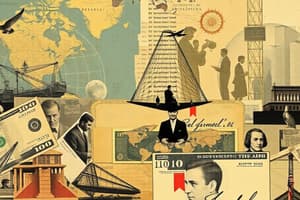Podcast
Questions and Answers
Which historical trade route, introduced by China, facilitated the global transport of goods and was known as the 'central Eurasian world trade route'?
Which historical trade route, introduced by China, facilitated the global transport of goods and was known as the 'central Eurasian world trade route'?
- Trans-Saharan Trade
- Spice Route
- Silk Road (correct)
- Galleon Trade
Which of the following best describes the primary goal of the Bretton Woods System established in 1944?
Which of the following best describes the primary goal of the Bretton Woods System established in 1944?
- To prevent another global economic depression and foster international economic cooperation (correct)
- To promote isolationist economic policies among nations
- To create a system of fixed exchange rates based on the British pound
- To establish a gold standard for international currencies
What role did the U.S. dollar play in the Bretton Woods System?
What role did the U.S. dollar play in the Bretton Woods System?
- It was devalued to encourage exports from other countries.
- It was pegged to the price of gold, limiting its fluctuation.
- It was replaced by a basket of currencies to reduce reliance on a single nation.
- It was adopted as the standard 'global currency' to establish stable international exchange rates. (correct)
How does economic globalization, as defined by Hamilton (2008), manifest itself?
How does economic globalization, as defined by Hamilton (2008), manifest itself?
In the context of the global economy, what is meant by the term 'industrial upgrading'?
In the context of the global economy, what is meant by the term 'industrial upgrading'?
Which of the following is a defining characteristic of Intergovernmental Organizations (IGOs)?
Which of the following is a defining characteristic of Intergovernmental Organizations (IGOs)?
How do Supranational Organizations differ from Intergovernmental Organizations (IGOs)?
How do Supranational Organizations differ from Intergovernmental Organizations (IGOs)?
Which of the following is a key function of Non-Governmental Organizations (NGOs)?
Which of the following is a key function of Non-Governmental Organizations (NGOs)?
What is a primary activity of Multinational Corporations (MNCs) and Transnational Corporations (TNCs) in the global economy?
What is a primary activity of Multinational Corporations (MNCs) and Transnational Corporations (TNCs) in the global economy?
Which outcome is most directly associated with market integration?
Which outcome is most directly associated with market integration?
How do Trade-Related Aspects of Intellectual Property Rights (TRIPS) function within the framework of global trade?
How do Trade-Related Aspects of Intellectual Property Rights (TRIPS) function within the framework of global trade?
Why might a country require foreign companies to use local materials or hire local workers?
Why might a country require foreign companies to use local materials or hire local workers?
What is trade liberalization intended to achieve?
What is trade liberalization intended to achieve?
What is the main purpose of regional integration among countries?
What is the main purpose of regional integration among countries?
Which of the following best describes a key attribute of global corporations?
Which of the following best describes a key attribute of global corporations?
What is a potential disadvantage of global corporations?
What is a potential disadvantage of global corporations?
What has challenged the autonomy of nation-states?
What has challenged the autonomy of nation-states?
What does Benedict Anderson mean by the term 'imagined community' in the context of a nation?
What does Benedict Anderson mean by the term 'imagined community' in the context of a nation?
What is the significance of the Treaty of Westphalia (1648) in the context of the modern nation-state system?
What is the significance of the Treaty of Westphalia (1648) in the context of the modern nation-state system?
How is the concept of 'nation' defined in the context of the nation-state?
How is the concept of 'nation' defined in the context of the nation-state?
What principle was established by the Treaty of Westphalia regarding relations between countries?
What principle was established by the Treaty of Westphalia regarding relations between countries?
What is the primary focus of nationalism as a principle of the interstate system?
What is the primary focus of nationalism as a principle of the interstate system?
What is a defining characteristic of international organizations (IGOs)?
What is a defining characteristic of international organizations (IGOs)?
As globalization grows, what change impacts the power of the nation-state?
As globalization grows, what change impacts the power of the nation-state?
According to Karns and Mingst, what does global governance encompass?
According to Karns and Mingst, what does global governance encompass?
What is a key role of the United Nations (UN)?
What is a key role of the United Nations (UN)?
Which of the following is identified as a 'gap' in global governance?
Which of the following is identified as a 'gap' in global governance?
What is a major global issue facing the world today?
What is a major global issue facing the world today?
Which of the following reflects a key idea from the text about the future of global governance?
Which of the following reflects a key idea from the text about the future of global governance?
What characterizes the 'porosity' of the nation-state in the context of Globalization?
What characterizes the 'porosity' of the nation-state in the context of Globalization?
What activity is typically associated with Multinational Corporations (MNCs)?
What activity is typically associated with Multinational Corporations (MNCs)?
Following the logic of the text, why might a country intentionally lower prices and wages?
Following the logic of the text, why might a country intentionally lower prices and wages?
Which entity replaced the General Agreement on Tariffs and Trade (GATT), focusing on reducing non-tariff barriers and ensuring free trade?
Which entity replaced the General Agreement on Tariffs and Trade (GATT), focusing on reducing non-tariff barriers and ensuring free trade?
What is the purpose of the International Monetary Fund (IMF)?
What is the purpose of the International Monetary Fund (IMF)?
Which of these trade relationships were not listed as being established historically?
Which of these trade relationships were not listed as being established historically?
What best describes how a country's worldwide economic status plays a role in the global arena?
What best describes how a country's worldwide economic status plays a role in the global arena?
What is the role of the Economic and Social Council (ECOSOC) of the UN?
What is the role of the Economic and Social Council (ECOSOC) of the UN?
What is a consequence of the increasing demand for commodities?
What is a consequence of the increasing demand for commodities?
What is the relationship between trade and international relations?
What is the relationship between trade and international relations?
How did the Bretton Woods System aim to prevent a repeat of the Great Depression?
How did the Bretton Woods System aim to prevent a repeat of the Great Depression?
What is the primary distinction between Intergovernmental Organizations (IGOs) and Supranational Organizations?
What is the primary distinction between Intergovernmental Organizations (IGOs) and Supranational Organizations?
What is the effect of countries lowering prices and wages to attract investment?
What is the effect of countries lowering prices and wages to attract investment?
How do Trade-Related Investment Measures (TRIMS) function in global trade?
How do Trade-Related Investment Measures (TRIMS) function in global trade?
What is a challenge presented by the increasing porosity of nation-states due to globalization?
What is a challenge presented by the increasing porosity of nation-states due to globalization?
Flashcards
Economy
Economy
The basic foundation influencing society's condition, including politics.
Worldwide economic status
Worldwide economic status
A country's economic standing that indicates adaptability in the global market.
The Silk Road
The Silk Road
An early trade route introduced by China facilitating global movement of goods.
Bretton Woods System (1944-1971)
Bretton Woods System (1944-1971)
Signup and view all the flashcards
General Agreement on Tariffs and Trade (GATT)
General Agreement on Tariffs and Trade (GATT)
Signup and view all the flashcards
World Trade Organization (WTO)
World Trade Organization (WTO)
Signup and view all the flashcards
International Monetary Fund (IMF)
International Monetary Fund (IMF)
Signup and view all the flashcards
Economic globalization
Economic globalization
Signup and view all the flashcards
Trade
Trade
Signup and view all the flashcards
Global economy
Global economy
Signup and view all the flashcards
Global trade networks
Global trade networks
Signup and view all the flashcards
Global value chains
Global value chains
Signup and view all the flashcards
Demand for commodities
Demand for commodities
Signup and view all the flashcards
Oil
Oil
Signup and view all the flashcards
"Race to the bottom"
"Race to the bottom"
Signup and view all the flashcards
"Industrial upgrading"
"Industrial upgrading"
Signup and view all the flashcards
Intergovernmental Organizations (IGOs)
Intergovernmental Organizations (IGOs)
Signup and view all the flashcards
Supranational Organizations
Supranational Organizations
Signup and view all the flashcards
Non-Governmental Organizations (NGOs)
Non-Governmental Organizations (NGOs)
Signup and view all the flashcards
Advocacy NGOs
Advocacy NGOs
Signup and view all the flashcards
Operational NGOs
Operational NGOs
Signup and view all the flashcards
Multinational Corporations (MNCs)
Multinational Corporations (MNCs)
Signup and view all the flashcards
Transnational Corporations (TNCs)
Transnational Corporations (TNCs)
Signup and view all the flashcards
Importing/exporting
Importing/exporting
Signup and view all the flashcards
Buying and Selling Licenses
Buying and Selling Licenses
Signup and view all the flashcards
Market Integration
Market Integration
Signup and view all the flashcards
Expands market coverage
Expands market coverage
Signup and view all the flashcards
IMF (International Monetary Fund)
IMF (International Monetary Fund)
Signup and view all the flashcards
World Bank
World Bank
Signup and view all the flashcards
WTO (World Trade Organization)
WTO (World Trade Organization)
Signup and view all the flashcards
TRIPS (Trade-Related Aspects of Intellectual Property Rights)
TRIPS (Trade-Related Aspects of Intellectual Property Rights)
Signup and view all the flashcards
TRIMS (Trade-Related Investment Measures)
TRIMS (Trade-Related Investment Measures)
Signup and view all the flashcards
Privatization
Privatization
Signup and view all the flashcards
Deregulation
Deregulation
Signup and view all the flashcards
Foreign Direct Investment (FDI)
Foreign Direct Investment (FDI)
Signup and view all the flashcards
Trade Liberalization
Trade Liberalization
Signup and view all the flashcards
Regional Integration
Regional Integration
Signup and view all the flashcards
Global Corporations
Global Corporations
Signup and view all the flashcards
General Assembly
General Assembly
Signup and view all the flashcards
Security Council
Security Council
Signup and view all the flashcards
Economic and Social Council (ECOSOC)
Economic and Social Council (ECOSOC)
Signup and view all the flashcards
Governance
Governance
Signup and view all the flashcards
United Nations (UN)
United Nations (UN)
Signup and view all the flashcards
Knowledge gap
Knowledge gap
Signup and view all the flashcards
Normative gap
Normative gap
Signup and view all the flashcards
Study Notes
The Global Economy
- Economy is the basic foundation that influences society and politics
- A country's worldwide economic status indicates its economic mobility
- Economic mobility is a major factor in global competitiveness
- Historically, the Philippines bartered with China for porcelains, silk, etc.
- Spain implemented the Galleon Trade in the Philippines
- China introduced the Silk Road as the central Eurasian world trade route
Bretton Woods System (1944-1971)
- The system was created after World War II to prevent another Great Depression
- The Bretton Woods System established international economic cooperation
- The cooperation facilitated free capital flow worldwide
- The US dollar became the standard "global currency"
- The US dollar established stable international exchange rates
- The system led to global economic structures
- The General Agreement on Tariffs and Trade (GATT) sought to liberalize trade by reducing tariff barriers
- The World Trade Organization (WTO) replaced GATT
- The WTO focuses on reducing non-tariff barriers and ensuring free trade
- The International Monetary Fund (IMF) was created to stabilize global monetary systems
Economic Globalization & Trade
- Economic globalization involves trading and investing between countries
- Trade is a driving force behind international relations
- Trade impacts nearly every aspect of society
- The global economy involves the decentralization of production
- Command and control are simultaneously centralized within global cities
- Global trade operates through supply chains
- Global trade operates through international production networks
- Global trade operates through global commodity chains
- Global trade operates through global value chains
- Global value chains track value creation through different stages
Global Commodity Demand & Economic Disparity
- The demand for commodities is skyrocketing due to increased consumption in developing countries like China
- Oil scarcity leads to increased prices and geopolitical tensions
- Some countries lower prices and wages to attract investment
- Lowering prices and wages leads to "race to the bottom" competition
- Initially, countries like China and Mexico entered the world market with low-cost production
- China and Mexico moved to higher-value production at higher wages ("industrial upgrading")
Actors in Globalization
- Categories of Organizations in globalization can include:
- Intergovernmental Organizations (IGOs)
- Supranational Organizations
- Non-Governmental Organizations (NGOs)
- Multinational Corporations (MNCs) & Transnational Corporations (TNCs)
Intergovernmental Organizations (IGOs)
- IGOs are composed primarily of sovereign states or other IGOs
- Treaties establish IGOs, giving them international personality
- Examples are World Trade Organization (WTO), World Health Organization (WHO), and Asian Development Bank (ADB)
Supranational Organizations
- Supranational Organizations extend beyond the borders of multiple states
- They promote economic, political, or cultural unity
- Examples are United Nations (UN), International Labor Organization (ILO), and European Union (EU)
Non-Governmental Organizations (NGOs)
- NGOs operate independently of governments
- Advocacy NGOs influence governments on specific issues
- Operational NGOs provide services
- Amnesty International, International Red Cross, and International Chamber of Commerce are examples of NGOs
Multinational Corporations (MNCs) & Transnational Corporations (TNCs)
- MNCs operate in multiple countries and control goods and services production
- TNCs have substantial facilities and conduct business in multiple countries
- Both MNCs and TNCs are involved in importing/exporting goods and services
- Both MNCs and TNCs make significant investments in foreign countries
- Both MNCs and TNCs buy and sell licenses in international markets
- Both MNCs and TNCs engage in contract manufacturing with local producers
- Both MNCs and TNCs open manufacturing/assembly operations abroad
Market Integration
- Market integration is when related markets experience similar price trends
- Market integration can be intentional (government policies) or unintentional (supply-demand shifts)
- Market integration expands market coverage by selling local products in the global market
- Market integration reduces market failures
- Market integration equalizes prices across integrated markets
International Financial Institutions
- The IMF (International Monetary Fund) ensures monetary stability and manages exchange rates
- The World Bank provides funds for government-sponsored development projects
- The WTO (World Trade Organization) facilitates free trade agreements
- The WTO oversees trade-related aspects of intellectual property (TRIPS)
- The WTO manages Trade-Related Investment Measures (TRIMs)
TRIPS & TRIMS in Global Trade
- Trade-Related Aspects of Intellectual Property Rights (TRIPS) is a global agreement under the WTO
- TRIPS protects intellectual property rights, e.g., patents, copyrights, trademarks
- TRIPS ensures intangible ideas, movies, books, music, software, are protected worldwide
- TRIPS helps prevent unauthorized use of intellectual property
- Trade-Related Investment Measures (TRIMS) are rules imposed on foreign businesses
- TRIMS prevents unfair trade practices and ensures that foreign investments do not distort trade
- Some countries require foreign companies to use local materials or hire local workers to encourage domestic growth
Global Economic Integration Factors
- Privatization is the transfer of state-owned businesses to private ownership
- Deregulation is the removal of government restrictions on economic activity
- Foreign Direct Investment (FDI) is an investment by a foreign company in another country
- Trade Liberalization is the reduction or elimination of trade barriers like tariffs and quotas
- Regional Integration is when countries cooperate for economic, political, and social benefits
Attributes of Global Corporations
- Global corporations operate on a global scale
- Global corporations have huge assets and turnovers in multiple countries
- Global corporations are run by centralized management with headquarters in a single country
- Global corporations exert high economic influence over global markets
- Global corporations use advanced technology for production and marketing
- Global corporations employ top executives and managers for efficient operations
Advantages & Disadvantages of Global Corporations
- Advantages of global corporations include foreign capital investment, job creation, technological advancement, increased exports and healthy competition
- Disadvantages of global corporations include exploiting local industries, adverse effects on local business, cultural homogenization, influence on government policies and environmental concerns
Key Takeaways for the Global Economy
- The global economy is shaped by historical trade systems, post-WWII economic frameworks, and modern financial institutions
- Globalization is driven by organizations, corporations, and financial institutions
- Market integration affects price stability, trade liberalization, and investment flows
- Global corporations have both positive and negative impacts on local and global economies
The Global Interstate System
- The modern nation-state traces its origins to the Treaty of Westphalia (1648)
- This treaty led to the notion that nation-states are autonomous
- The treaty gave nation-states complete control over their domestic affairs
- Globalization has led to a loss of control over economic flows and transnational organizations
- A debate emerged over whether the "nation-state is dead"
- The nation state remains an important political structure despite its declining power
Porosity of the Nation-State
- With globalization, borders are becoming more open to trade, migration, and information
Benedict Anderson’s "Imagined Community"
- The nation is socially and politically constructed through print capitalism (e.g., newspapers, books)
- People identify with a shared culture despite never meeting all members of the nation
- The nation-state transcends geography, adapting to technology and immigration flows
The Nation-State
- The nation-state consists of two key concepts: State and Nation
State
- A country and its government has a defined territory, sovereignty (freedom from external control), and an organized government
Nation
- Benedict Anderson defined it as an "imagined community"
- A nation has boundaries, meaning not everyone can be a citizen
- A nation shares a language, traditions, and ethnicity
The Interstate System
- The interstate system is a system of competing and allying states
- The interstate system was shaped by the Treaty of Westphalia (1648)
- The Treaty of Westphalia ended the Thirty Years' War in Europe
- The Treaty of Westphalia established the principle of sovereignty
- The Treaty of Westphalia created that countries should not interfere in each other’s affairs
- The Treaty of Westphalia provided stability for European nations
Principles of the Interstate System
- Nationalism see nations as the basis of political structures
- Nationalism promotes national unity and interests above others
- Internationalism fosters cooperation among nations
- Internationalism involves political, economic, and social partnerships
Effects of Globalization on Governments
- Governments work with international organizations during political globalization
- Examples of international organizations are the United Nations (UN) and Non-Governmental Organizations (NGOs)
- These organizations help manage relief efforts, environmental protection, and immigration
- International Organizations (IGOs) are created by nation-states to handle issues beyond their borders
- IGOs operate on intergovernmental principles (agreements require unanimous consent)
- IGOs have supranational power, meaning members must follow their rules or leave
- Examples of IGO are European Union (EU) (regional level) and World Trade Organization (WTO) (global level)
The Decline of the Nation-State
- The power of the nation-state is weakening due to globalization
- While still sovereign, states are privatizing responsibilities like water, health care, and education
- While states are losing influence to transnational corporations (TNCs) and NGOs
- International organizations are becoming stronger, possibly evolving into a "global government"
Contemporary Global Governance
- Governance is the establishment of policies and monitoring their implementation
- Karns and Mingst defined Global Governance as
- A collection of governance-related activities, rules, and mechanisms, formal and informal, existing at a variety of levels in the world today."
- Global Governance deals with global issues such as armed conflicts, technology risks, economic stability, and climate change
Roles and Functions of the United Nations (UN)
- The UN is an intergovernmental organization
- The UN promotes international peace and order
- The UN replaced the League of Nations, which failed to prevent World War II
- The UN was founded on October 24, 1945, after World War II
Goals of the UN
- The UN wants to maintain peace and security
- The UN wants to foster friendly relations between countries
- The UN helps countries to solve problems together
- The UN promotes human rights worldwide
Main Organs of the UN
- General Assembly- The main decision-making body
- Security Council- Maintains international peace and security
- Secretariat- An administrative body led by the Secretary-General
- Trusteeship Council- Oversaw trust territories
- Economic and Social Council (ECOSOC)- Handles development and human rights
- International court of justice- Resolves legal disputes between countries
Achievements of the UN
- The UN has helped countries become democratic and peaceful
- The UN has addressed environmental issues (e.g., Earth Summit 1992 on climate change)
- The International Atomic Energy Agency (IAEA) monitors nuclear weapons
- The UN fights poverty, drug trafficking, and hunger
Challenges of Global Governance
- Weis (2015) identified five gaps in global governance:
- Knowledge gap: countries lack access to critical information
- Normative gap: need for universal rules and ethical standards
- Policy gap: lack of effective international policies
- Institutional gap: some institutions lack power to enforce rules
- Compliance gap: countries do not always follow agreements
Major Global Issues
- The world is facing terrorism
- The world is facing nuclear proliferation
- The world is facing humanitarian crises
- The world is facing climate change
- The world is facing human rights violations
- The world is facing global pandemics (e.g. Flu viruses)
Future of Global Governance
- The Global institutions need reforming (e.g. UN security council)
- There needs to be stronger enforcement of global rules
- Ensuring benefits of globalization reach all nations is important
Key Takeaways for Global governance
- The nation-state system emerged from the Treaty of Westphalia but is now challenged by globalization
- IGOs and NGOs are taking on responsibilities once held by nation-states
- The UN plays a critical role in global governance but faces challenges in policy enforcement and international cooperation
- Global governance must evolve to address modern issues like terrorism, climate change, and pandemics
Studying That Suits You
Use AI to generate personalized quizzes and flashcards to suit your learning preferences.




